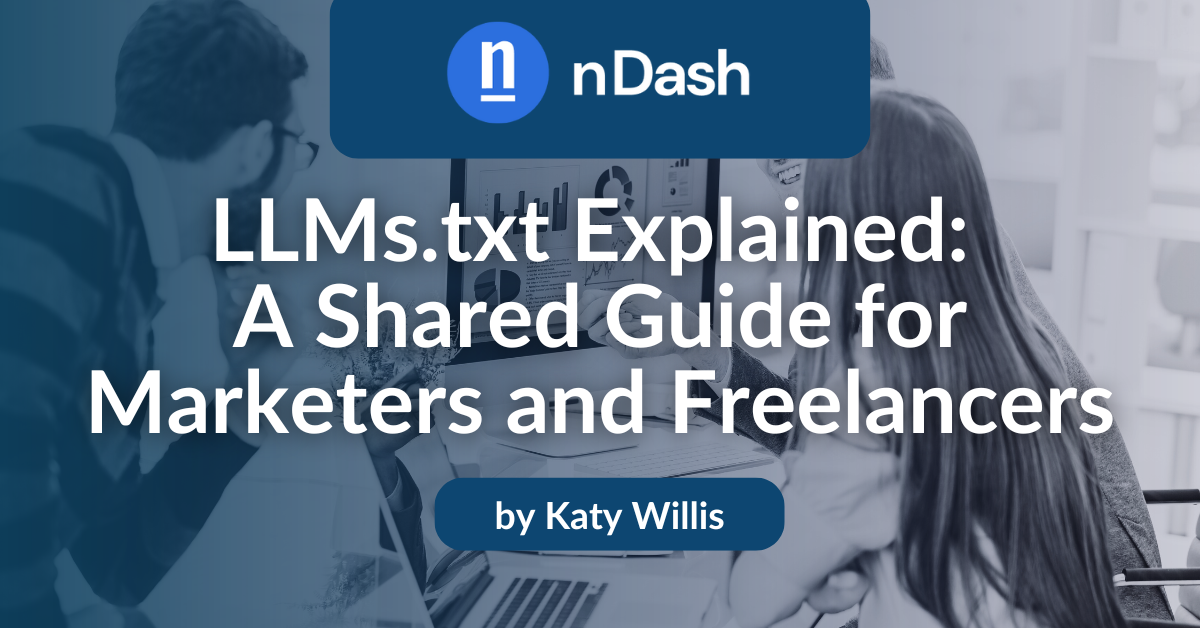LLMs.txt is a proposed new standard that allows site owners to control how AI models access their content. It gives marketers and freelance writers unprecedented control over their content’s visibility.
Understanding LLMs.txt and Its Purpose
In essence, LLMs.txt addresses the rise of generative AI and its notorious content scraping and regurgitation. LLMs.txt would give creators more control over their content.
What Is LLMs.txt?
LLMs.txt is a text file placed at your website’s root that acts as a curated menu for AI models. It looks like this: yourwebsite.com/llms.txt. Unlike robots.txt, which blocks web crawlers, LLMs.txt directs LLMs (Large Language Models) to your most important, AI-friendly content.
The file uses a structured markdown format that both humans and AI can easily read. You list high-quality pages you want AI systems to ingest, understand, and potentially cite when answering user questions.
Why It Was Created
Traditional SEO sitemaps list every page, but AI models face unique constraints. They can’t easily digest large, navigation-heavy websites and need guidance to find concise, relevant information. As AI-driven search features draw on web content, LLMs.txt gives site owners a direct line to these AI systems.
The standard also emerged from growing concerns about consent in AI content usage. Publishers and creators wanted more transparency in how their work trains or informs AI models. LLMs.txt helps balance opportunity with control, boosting visibility in AI results while giving content owners a voice.
Robots.txt vs. LLMs.txt: What’s New?
The key difference is that robots.txt tells bots what not to crawl, while LLMs.txt tells AI models what to focus on.
Built for Generative AI
Robots.txt and LLMs.txt serve completely different purposes. Robots.txt is a decades-old standard that lets site owners allow or exclude crawlers from specific parts of their site. LLMs.txt is a new standard for AI inference and training contexts rather than web indexing.
Robots.txt is about exclusion, while LLMs.txt is about curation. It addresses AI models’ unique needs, like small context windows and requirements for clean text, but highlights concise, important content.
New Controls, New Implications
Generative AI has introduced new content controls beyond LLMs.txt. OpenAI’s GPTBot crawler now respects standard robots.txt rules, so site owners can opt out of feeding AI training data. Google introduced Google-Extended, which you can also block via robots.txt. This is an interesting one because it allows search indexing while blocking AI training.
How LLMs.txt Impacts SEO Strategy
Even if traditional SEO strategies still work, the search landscape is changing so rapidly and includes search in AI models. So getting organic traffic is more challenging than ever. However, LLMs.txt helps to level the playing field.
Search Visibility Is No Longer Just Google
Traditional SEO focused on Google rankings and keyword competition, but visibility now includes AI-driven results. But now, visibility includes appearing in AI-driven results. Google’s AI Overviews provide quick answers at the top of search results. And now, over 58% of Google searches result in zero clicks. So users are getting answers without visiting creators’ sites.
By late 2024, Google’s AI summaries appeared in roughly 47% of all searches, mostly for informational queries. This shift makes SEO for AI as important as traditional SEO. And since these numbers vary by industry (e.g., finance, health, and education), marketers should monitor visibility metrics in their specific verticals.
Marketers and content creators need to make sure their content is optimized for AI models, not just for blue links.
Blocked Content = Lower AI Exposure
If you block AI models from accessing your content, your brand’s exposure on those platforms drops. Major publishers like The New York Times updated their robots.txt to block OpenAI’s GPTBot and Google’s AI crawler. While this protects intellectual property, it means their content won’t appear in AI-driven answers where competitors’ might.
But while visibility matters, blocking AI also protects proprietary research, strategic insights, and brand voice. It can prevent unauthorized mimicry, ensure compliance with internal policies, and help preserve content for human readers rather than machine learning.
The trade-off is real: opting out reduces potential AI-driven reach. However, opting in allows models to ingest, train on, and potentially reproduce your content without context or credit.
If your site is a niche authority, blocking AI could reduce the chances of future audiences discovering your work via AI interfaces. However, for some brands, retaining control and avoiding misuse outweighs the exposure benefit. Each organization must weigh its strategic goals, risk tolerance, and ethical stance before making a decision.
Marketers and Writers Must Align
These changes require marketers and freelance writers to coordinate strategies. Marketers typically want maximum visibility and wide content distribution. Writers worry about recognition and future work when AI uses their content without credit.
Marketers should discuss AI content guidelines with writers from the start. If a company plans to add LLMs.txt, contributors should know how their content will appear on AI platforms. Conversely, if a publication opts out of AI training, that might appeal to those writers worried about protecting their voice.
Legal ownership matters too. Once paid, clients typically own freelance-created content. So they have the right to decide if AI bots can crawl it.
What Freelance Writers Should Consider
As a freelancer, you’ve got to think about who owns your content. Where it is distributed, and what conversations and steps you can take with clients.
Who Owns the Content You Create?
In most work-for-hire arrangements, clients own content once you’ve delivered and been paid. So they can include your work in LLMs.txt files or allow AI bot scraping without permission.
If you object to your work training AI without permission, communicate this early. Some writers negotiate contract clauses about AI usage rights or avoid clients who openly feed content to AI. Others embrace AI exposure to reach more readers through AI platforms.
Your Name, Your Voice
LLMs digest countless writing samples from the web, possibly including your authored content, and can produce text in similar tones. This means your voice could be mimicked without credit.
AI search overviews might cite websites or brands but skip bylines, potentially diminishing the personal brand you’ve built. Consider how you feel about AI answering questions in a voice that echoes yours.
Some writers choose ghostwriting for pieces likely to be widely scraped, avoiding confusion with their personal portfolio. Others push for policies requiring AI-derived content to link back to originals. Your voice is part of your value, so be proactive about preserving its integrity.
Start the Conversation with Clients
Talk with clients about AI policies. Many haven’t considered whether to allow or block AI crawlers, and your questions could prompt them to establish guidelines.
Use this conversation to set expectations. If a client freely allows AI training, you might request higher rates, recognizing wider content use. If you oppose AI training usage, ask if they’ll disallow it via robots.txt. Forward-thinking businesses increasingly add AI clauses to contracts to protect writers’ work.
What Marketers Should Do Right Now
As a marketer, you need to audit your content access. Weigh up whether or not you want to adopt or limit LLM use.
Review Your Robots.txt and Add LLMs.txt
Examine your site’s robots.txt file immediately. Does it address AI crawlers? If not, decide on your strategy.
You can use robots.txt to disallow known AI bots like GPTBot and Google-Extend without impacting normal search indexing.
Implement an LLMs.txt file using the official specification. List your most important content URLs with brief descriptions using markdown structure. This puts a signpost on your site saying, “Hey AI, this is our recommended content!” Major AI companies have started looking for LLMs.txt when crawling, giving you a competitive edge.
Clarify Your AI Content Policy
Create your AI content policy now. Cover incoming usage (how you handle outside AI access to your content) and outgoing usage (your team’s AI tool boundaries). Thought leadership companies might restrict AI writing, while others embrace AI for efficiency.
Document everything clearly. Your policy should address training permissions, LLMs.txt decisions, and content creation rules. Share it internally and publicly through your website or terms of service. This prevents confusion and keeps everyone from SEO teams to freelance writers aligned on what’s allowed.
Align with Content Creators
Treat content creators as partners, not vendors. Share your LLMs.txt and AI decisions upfront. If you’re including their work, explain the exposure benefits. If blocking AI, share your reasoning (protecting research, company ethics).
Listen to their attribution and ownership concerns. Update contracts to address AI usage rights explicitly. When hiring writers, establish these terms from the start. This transparency builds trust and delivers better results when everyone’s aligned.
Shaping the Future of Ethical Content Use
For this to work, there is a shared responsibility between marketers and writers in defining how AI treats their work and who has the right to it.
A Shift Toward Consent and Transparency
LLMs.txt represents a broader industry shift towards consent and transparency. Early AI model training involved mass web scraping, largely under the radar. This drew significant backlash from creators and publishers, prompting new efforts to regain control.
But it’s important to note: LLMs.txt is a signal, not an enforcement mechanism. It doesn’t technically block crawlers like robots.txt does. Instead, it communicates preferences and usage boundaries to AI companies that voluntarily honor them.
This makes it a starting point for establishing responsible AI practices, not a guarantee. Still, adoption matters. The more creators who implement LLMs.txt, the more pressure AI companies face to respect those preferences, especially as regulation catches up.
Transparency builds momentum toward better norms. LLMs.txt alone won’t solve content misuse, but it signals intent and sparks important conversations.
Collaboration is Key
No single group can decide how content and AI coexist. Collaboration across roles on content access decisions, licensing agreements, and future protections is the key to real progress and success. Widespread LLMs.txt adoption will encourage AI companies to respect creator guidance. But a clear LLMs.txt policy and open conversations between writers and clients are an ethical must.
Moving Forward with Clarity and Control
The path ahead requires you to decide whether implementing LLMs.txt is the right choice for your brand. You also need to work on aligning strategies between marketers and writers. And focus on championing consent to ensure content thrives on your terms in AI-driven search and discovery.
About the author:
 Katy is a seasoned freelance writer, editor, and content manager specializing in creating high-quality, SEO-driven content for diverse industries. With over two decades of experience, she has collaborated with businesses, charities, and entrepreneurs to craft engaging content. Check out her writer profile to learn how her expertise can help level up your content strategy: Katy Willis.
Katy is a seasoned freelance writer, editor, and content manager specializing in creating high-quality, SEO-driven content for diverse industries. With over two decades of experience, she has collaborated with businesses, charities, and entrepreneurs to craft engaging content. Check out her writer profile to learn how her expertise can help level up your content strategy: Katy Willis.
